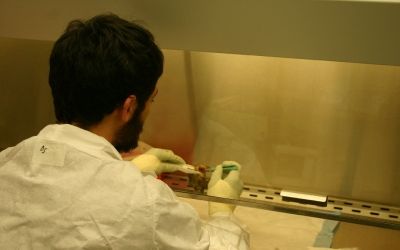Researchers Unlocking the Secrets of Cross-Species Rabies Transmission
Like most infectious diseases, rabies can attack several species. However, which species are going to be infected and why turns out to be a difficult problem that represents a major gap in our knowledge of how diseases emerge.


A team of researchers led by a UGA ecologist found that, depending upon the species involved, a single infected bat may infect between 0 and 2 members of a different species and that, on average, the probability of cross-species transmission occurs only once for every 73 transmissions within the same species. Here, lead author Daniel Streicker collects a tissue sample from a rabid pallid bat (Antrozous pallidus) for viral sequencing. Photo courtesy of Felix Jackson/Centers for Disease Control and Prevention
By Beth Gavrilles
Like most infectious diseases, rabies can attack several species. However, which species are going to be infected and why turns out to be a difficult problem that represents a major gap in our knowledge of how diseases emerge. A paper just published in the journal Science by a team of researchers led by Daniel G. Streicker, a PhD student in the University of Georgia Odum School of Ecology, has begun to close that knowledge gap.
The paper, co-authored by researchers from the Centers for Disease Control and Prevention (CDC), the University of Tennessee-Knoxville and Western Michigan University, provides among the first estimates for any infectious disease of how often a disease can be transmitted across species in complex, multi-host communities and the likelihood of disease establishment in a new host species.
"Rabies happens to be an ideal system to answer these questions," said Streicker. "Rabies occurs across the country, affects many different host species and is known to mutate frequently." Although cases of rabies in humans are rare in the U.S., bats are the most common source of these infections, according to the CDC.
To determine the rate at which rabies infects multiple species, Streicker and his colleagues used an enormous dataset, unprecedented in its scope, containing hundreds of rabies viruses from 23 North American bat species. They used gene sequencing and tools from population genetics to quantify how many cross-species transmission (CST) events were expected to occur between each pair of species from any infected individual. Their analysis showed that, depending upon the species involved, a single infected bat may infect between 0 and 2 members of a different species; and that, on average, the probability of cross-species transmission occurs only once for every 73 transmissions within the same species.
"Whats really important about this is that molecular sequence data, an increasingly cheap and available resource, can be used to quantify CST," said Streicker.
Associate professor Sonia Altizer, Streickers advisor in the Odum School, agreed. "This is a breakthrough," said Altizer. "The team defined, for the first time, a framework for quantifying the rates of CST across a network of host species that could be applied to other wildlife pathogens, and they developed novel methods to do it."
The researchers also looked at what factors allow diseases to move across species, such as foraging behavior, geographic range and genetics.
"Theres a popular idea that because of their potential for rapid evolution, the emergence of these types of viruses is limited more by ecological constraints than by genetic similarity between donor and recipient hosts," explained Streicker. "We wanted to see if that was the case."
They found, instead, that rabies viruses are much more likely to jump between closely related bat species than between ones that diverged in the distant past. Overlapping geographic range was also associated with CST, but to a lesser extent.
"CST and viral establishment do not occur at random, but instead are highly constrained by host-associated barriers," Streicker said. "Contrary to popular belief, rapid evolution of the virus isnt enough to overcome the genetic differences between hosts."
Streicker believes that what he and his colleagues have learned about bat rabies will be influential in understanding the ecology, evolution and emergence of many wildlife viruses of public health and conservation importance. "The basic knowledge weve gained will be key to developing new intervention strategies for diseases that can jump from wildlife to humans," he said.
Streicker is continuing his work with rabies and bats, with funding for a three-year study from the National Science Foundation. He and Altizer, in collaboration with investigators at the CDC, University of Michigan and the Peruvian Ministries of Health and Agriculture, will explore how human activities affect the transmission of the rabies virus in vampire bats in Peru and how those changes might feed back into altering the risk of rabies infection for humans, domesticated animals and wildlife.
"This kind of synthetic, interdisciplinary work is precisely what we aim for in the Odum School," said John Gittleman, Odum School dean. "The success of this research hinges on bringing together the fields of genetics, evolution and disease in a large-scale ecological context. Big problems in ecology will be solved in this way."
IDEA in Action: A Strategic Approach to Contamination Control
January 14th 2025Adopting IDEA—identify, define, explain, apply—streamlines contamination control. Infection control professionals can mitigate risks through prevention, intervention, and training, ensuring safer health care environments and reducing frequent contamination challenges.
Balancing Freedom and Safety: When Public Health Mandates Are Necessary
January 9th 2025Public health mandates, such as lockdowns, masking, and vaccination, balance liberty and safety, ensuring critical protections during pandemics like COVID-19 while fostering long-term survival through science.
Long-Term Chronicles: Infection Surveillance Guidance in Long-Term Care Facilities
January 8th 2025Antibiotic stewardship in long-term care facilities relies on McGeer and Loeb criteria to guide infection surveillance and appropriate prescribing, ensuring better outcomes for residents and reducing resistance.
Considering Avian Flu: World Health Organization Expert Warns Against Raw Milk
January 6th 2025Drinking raw milk poses risks of disease transmission, especially with H5N1 outbreaks. Expert Richard J. Webby, PhD, advises against raw cow or goat milk consumption due to its unpredictable and significant risks.